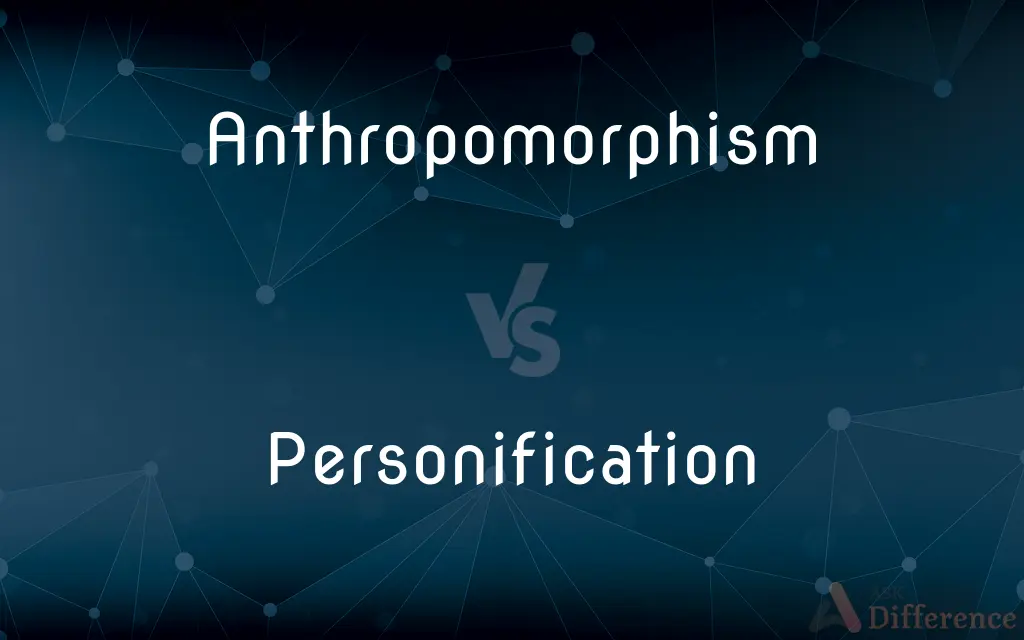Anthropomorphism vs. Personification — What's the Difference?
Edited by Tayyaba Rehman — By Urooj Arif — Updated on March 31, 2024
Anthropomorphism ascribes human traits to non-human entities, while personification gives non-human subjects human-like qualities in a figurative sense.

Difference Between Anthropomorphism and Personification
Table of Contents
ADVERTISEMENT
Key Differences
Anthropomorphism involves attributing human characteristics, emotions, and behaviors to animals, deities, or inanimate objects, suggesting these entities can exhibit human-like qualities. For example, in many children’s stories, animals talk, make decisions, and display emotions just as humans do. Personification, on the other hand, is a literary device used to give human-like qualities to abstract ideas or inanimate objects for the sake of imagery or symbolism, such as describing the wind as whispering secrets.
While anthropomorphism is often used to make non-human characters relatable in narratives or to conceptualize abstract entities in a more understandable way, personification serves to embellish literature, making descriptions more vivid and engaging. Anthropomorphic characters, like those in Aesop's fables, serve as protagonists or significant figures with fully developed personalities, whereas personification might describe a fleeting moment, like a storm raging in anger.
Anthropomorphism can blur the line between reality and fiction, especially in children's literature and animation, where animals or objects act in ways that are fundamentally human. This can help convey complex stories and morals. Personification, however, is typically used more sparingly, to add depth to narrative descriptions without suggesting that objects or concepts actually possess human consciousness or abilities.
The use of anthropomorphism can be found in religious texts, mythology, and folklore, where gods are depicted with human forms and attributes, making them more relatable to the human experience. In contrast, personification is a common rhetorical strategy in poetry and prose, used to evoke particular feelings or moods through the humanization of nature or inanimate objects.
Anthropomorphism has broader applications, including in the fields of robotics and artificial intelligence, where it influences how humans interact with technology, perceiving machines as having intent or emotions based on their design or behavior. Personification remains primarily a literary and artistic technique, with its effectiveness rooted in its ability to conjure vivid imagery and emotional resonance.
ADVERTISEMENT
Comparison Chart
Definition
Attributing human traits to non-humans.
Giving human-like qualities to abstractions or objects in a figurative sense.
Usage
Broad, including literature, religion, and technology.
Primarily literary, enhancing imagery and symbolism.
Purpose
Makes non-human entities relatable.
Adds depth and vividness to descriptions.
Examples
Animals in cartoons, gods in mythology.
Describing the wind as whispering, the storm as angry.
Representation
Can suggest actual possession of human qualities.
Symbolic, not implying real possession of qualities.
Compare with Definitions
Anthropomorphism
Personified Nature in Mythology.
Rivers and trees in myths that speak to humans or have human emotions.
Personification
Time Personified.
Time waits for no one, giving time the human ability to wait.
Anthropomorphism
Deities with Human Form.
Greek gods are often depicted with human bodies and emotions, engaging in human-like behaviors.
Personification
Abstract Ideas as Human.
Justice is blind, personifying justice as possessing a human characteristic.
Anthropomorphism
AI and Robotics.
Social robots are designed with facial expressions and voices to elicit empathetic responses from humans.
Personification
Nature with Human Qualities.
The leaves danced in the wind, describes leaves moving as if they could dance.
Anthropomorphism
Human Traits in Animals.
In Zootopia, animals live in a human-like society, working jobs and wearing clothes.
Personification
Emotions as Characters.
Loneliness sat quietly in the room, imagining loneliness as a person.
Anthropomorphism
Inanimate Objects Acting Human.
The movie Cars features vehicles that talk, feel, and form relationships.
Personification
Objects with Emotions.
The old house groaned in the storm, implying the house could express discomfort.
Anthropomorphism
Anthropomorphism is the attribution of human traits, emotions, or intentions to non-human entities. It is considered to be an innate tendency of human psychology.Personification is the related attribution of human form and characteristics to abstract concepts such as nations, emotions, and natural forces, such as seasons and weather.
Personification
The attribution of a personal nature or human characteristics to something non-human, or the representation of an abstract quality in human form
The book provides a sustained account of how literary personification works
Anthropomorphism
Attribution of human motivation, characteristics, or behavior to inanimate objects, animals, or natural phenomena.
Personification
A figure intended to represent an abstract quality
The knight is accompanied by two feminine personifications of vice
Anthropomorphism
The attribution of human characteristics and behavior to something not human.
Personification
The act of personifying.
Anthropomorphism
(theology) The attribution of human characteristics to divine beings.
Personification
A person or thing typifying a certain quality or idea; an embodiment or exemplification
"He's invisible, a walking personification of the Negative" (Ralph Ellison).
Anthropomorphism
The representation of the Deity, or of a polytheistic deity, under a human form, or with human attributes and affections.
Personification
A figure of speech in which inanimate objects or abstractions are endowed with human qualities or are represented as possessing human form, as in Hunger sat shivering on the road or Flowers danced about the lawn. Also called prosopopeia.
Anthropomorphism
The ascription of human characteristics to things not human.
Personification
Artistic representation of an abstract quality or idea as a person.
Anthropomorphism
The representation of objects (especially a god) as having human form or traits
Personification
A person, thing or name typifying a certain quality or idea; an embodiment or exemplification.
Adolf Hitler was the personification of anti-Semitism.
Personification
A literary device in which an inanimate object or an idea is given human qualities.
The writer used personification to convey her ideas.
Personification
An artistic representation of an abstract quality as a human
The Grim Reaper is a personification of death.
Personification
The act of personifying; impersonation; embodiment.
Personification
A figure of speech in which an inanimate object or abstract idea is represented as animated, or endowed with personality; prosopop ia; as, the floods clap their hands.
Personification
A person who represents an abstract quality;
She is the personification of optimism
Personification
Representing an abstract quality or idea as a person or creature
Personification
The act of attributing human characteristics to abstract ideas etc.
Common Curiosities
What is anthropomorphism?
Anthropomorphism is the attribution of human characteristics or behavior to non-human entities, such as animals or objects.
Why is anthropomorphism popular in children's literature?
It makes complex ideas more accessible and characters more relatable to children, enhancing engagement and understanding.
How do anthropomorphism and personification differ in usage?
Anthropomorphism is used across various contexts to make non-human entities relatable, while personification is mainly a literary tool to enhance imagery.
Can personification imply actual human qualities?
No, personification is figurative, adding depth to descriptions without suggesting objects or concepts truly possess human qualities.
Can anthropomorphism help in scientific research?
While it can aid in conceptualizing studies, excessive anthropomorphism must be avoided to ensure scientific accuracy and objectivity.
What is personification?
Personification is a literary device where human qualities are given to animals, inanimate objects, or abstract concepts.
Are there any criticisms of anthropomorphism?
Yes, it can lead to misunderstandings about animal behavior and nature, projecting human emotions and motivations where they may not exist.
Is personification used outside of literature?
While mainly literary, personification can be found in visual arts and speech to evoke imagery or convey emotions.
How do anthropomorphism and personification affect our perception of non-human entities?
They can make non-human entities seem more familiar and relatable, influencing our emotions and attitudes towards them.
How does personification enrich language?
It adds creativity and expressiveness to language, making descriptions more vivid and engaging for the reader.
Share Your Discovery

Previous Comparison
Bushing vs. Sleeve
Next Comparison
Industrial vs. IndustryAuthor Spotlight
Written by
Urooj ArifUrooj is a skilled content writer at Ask Difference, known for her exceptional ability to simplify complex topics into engaging and informative content. With a passion for research and a flair for clear, concise writing, she consistently delivers articles that resonate with our diverse audience.
Edited by
Tayyaba RehmanTayyaba Rehman is a distinguished writer, currently serving as a primary contributor to askdifference.com. As a researcher in semantics and etymology, Tayyaba's passion for the complexity of languages and their distinctions has found a perfect home on the platform. Tayyaba delves into the intricacies of language, distinguishing between commonly confused words and phrases, thereby providing clarity for readers worldwide.
















































